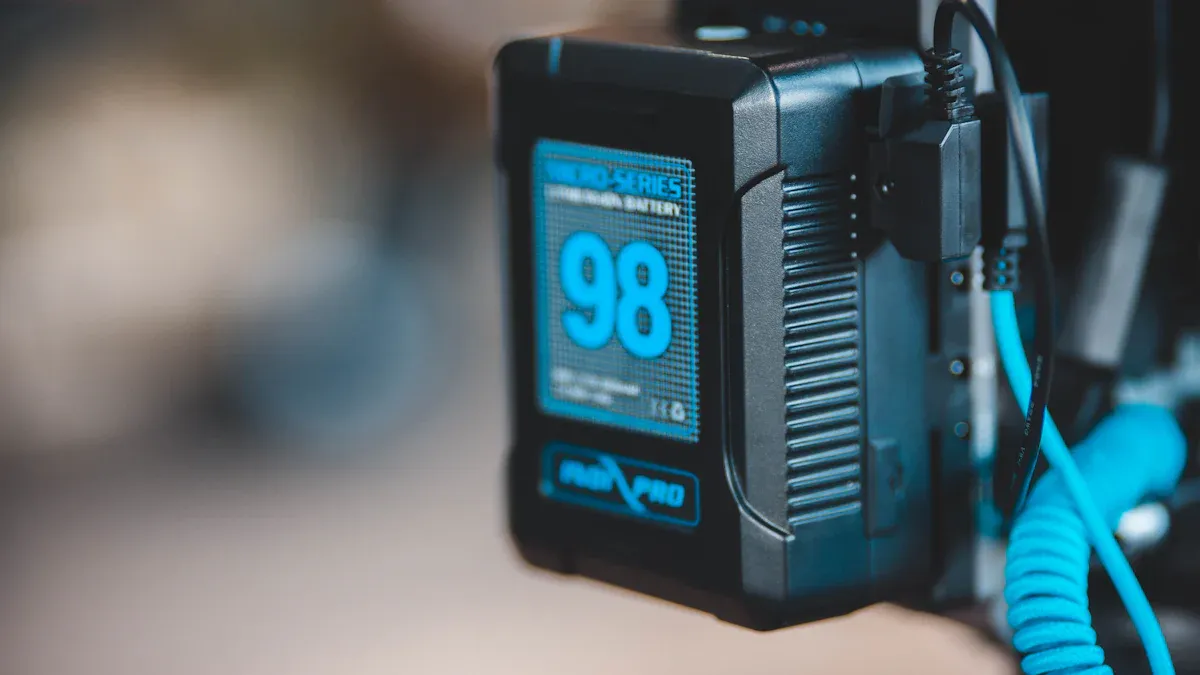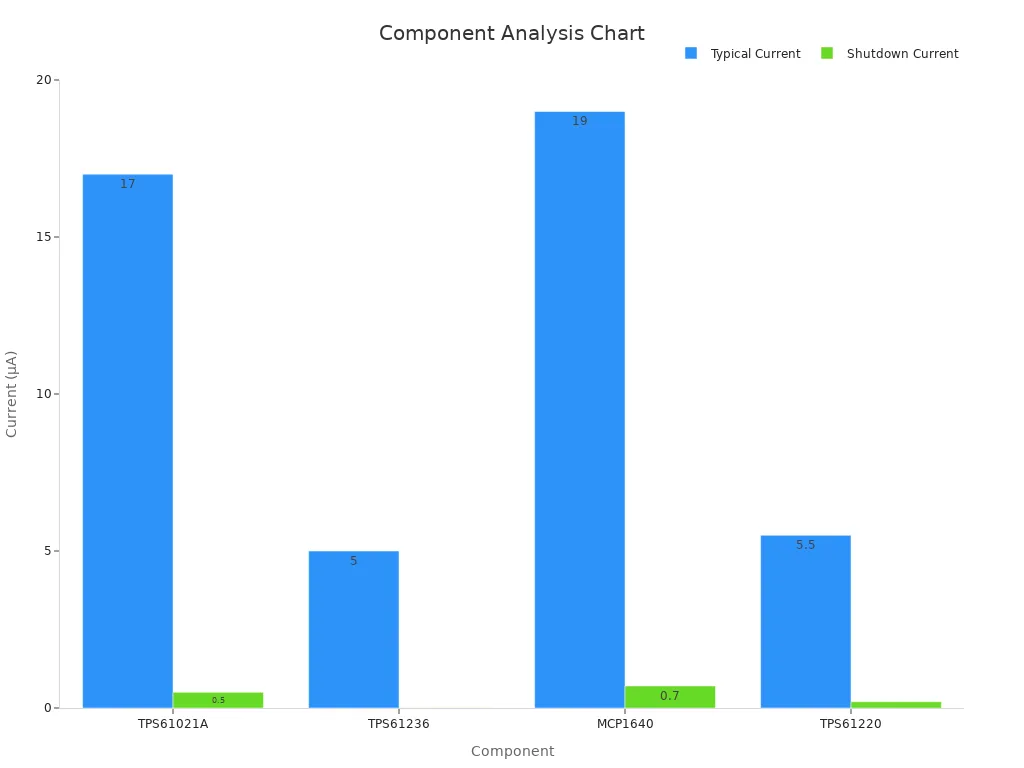Power Management TPS61021A Simplified for Everyday Use

The Power Management TPS61021A is a highly efficient boost converter chip. It effectively increases voltage and manages power, making it an excellent choice for energy-saving devices. Numerous IoT gadgets and wearables utilize the TPS61021A to extend battery life. Its compact size and efficiency are well-suited for modern technology.
Key Takeaways
The TPS61021A increases voltage well, perfect for saving power in IoT tools and wearable devices.
Its small size and great efficiency, up to 90%, make batteries last longer and waste less energy.
Use a simple setup guide to install it correctly. Pick the right parts and test the circuit carefully.
Overview of Power Management TPS61021A
Key Features and Specifications
The TPS61021A is a flexible boost converter IC. It works with input voltages from 0.5V to 5.5V. This makes it great for low-power sources like batteries. It can provide up to 5.5V output, fitting many electronic parts. Its efficiency, up to 90%, saves power and extends battery life.
This IC can handle up to 2A output current. This is perfect for small or medium loads. It uses only 15 µA in standby mode, saving energy. The TPS61021A has safety features like overcurrent protection and thermal shutdown. These make the circuit safer and more reliable.
Benefits in Power Management Applications
The TPS61021A makes power management easier for modern devices. It boosts voltage from low-power sources, keeping devices stable. Its high efficiency reduces wasted energy and helps batteries last longer. This is great for energy-saving gadgets.
Its small size helps save space in designs. The strong protection features prevent damage, making systems more reliable. The wide input voltage range allows use with different power sources. It works well with single-cell batteries or other low-voltage supplies.
Tip: Use the TPS61021A with ICs like the TPS61023 for higher currents or extra features.
Using the TPS61021A IC in Power Management
Step-by-Step Setup Guide
Setting up the TPS61021A IC is simple if done step by step. Follow these instructions to ensure it works well:
Understand Input and Output Needs
Find out the input voltage range and needed output voltage. The TPS61021A works with input voltages from 0.5V to 5.5V. It can boost the output voltage up to 5.5V. Make sure your power source, like a battery, fits these limits.Pick External Parts
Choose the right external parts, such as the inductor, capacitors, and resistors. For example:Use an inductor with a current rating higher than the IC's maximum output.
Pick capacitors with low ESR to keep the voltage steady.
Connect the Circuit
Set up the IC using the datasheet's wiring guide. Attach the input power source to the VIN pin and the load to the VOUT pin. Place external parts close to the IC to reduce noise.Test the Circuit
Turn on the circuit and check the output voltage. Confirm the IC boosts the voltage correctly. Adjust external parts if needed for better performance.
Tip: Always check the TPS61021A datasheet for detailed setup tips and part suggestions.
Circuit Design and Configurations
Designing a circuit with the TPS61021A IC needs careful planning for good results. Here are important design tips:
Inductor Choice
The inductor is key to the IC's function. Pick an inductor between 1 µH and 2.2 µH for most uses. Its current rating should be higher than the IC's maximum output to avoid problems.Capacitor Placement
Put input and output capacitors close to the IC. This reduces voltage changes and improves stability. Use ceramic capacitors with at least 10 µF for both input and output.Feedback Resistor Setup
The TPS61021A uses resistors to set the output voltage. Use the formula in the datasheet to pick resistor values. For example, to get a 5V output, choose resistors that match this voltage.PCB Layout
A good PCB layout helps reduce noise and keeps the circuit stable. Make input and output voltage paths short and wide. Place a ground layer under the IC to lower interference.
Note: Test your design with simulation tools before building the actual circuit.
Troubleshooting Common Problems
The TPS61021A IC works well, but some issues may happen. Here are common problems and fixes:
Unstable Output Voltage
If the voltage changes too much, check the capacitor values. Low capacitance can cause this issue. Replace them with larger or lower ESR capacitors.Overheating
Overheating happens if the IC runs near its current limit. Make sure the inductor and capacitors meet the specs. Add thermal vias or a heat sink to cool it down.No Output Voltage
If there’s no output voltage, check all connections. Ensure the input voltage is within the supported range. Verify the feedback resistor values are correct.High Noise Levels
Too much noise can come from a bad PCB layout. Fix the layout by shortening traces and improving grounding. Adding a ferrite bead to the input line can also help reduce noise.
Reminder: Always use the TPS61021A datasheet for troubleshooting and technical advice.
Applications of the TPS61021A IC

Use Cases in Consumer Electronics
The TPS61021A IC is important for today’s electronics. It boosts voltage efficiently, making it great for stable power. Many portable devices like cameras, gaming consoles, and keyboards use it. These gadgets often run on single-cell batteries. The IC helps save power and makes batteries last longer.
Its small size allows smaller and lighter designs. For example, in Bluetooth speakers, it powers amplifiers for clear sound. In e-readers, it keeps the display and parts working as the battery drains.
The IC has safety features like overcurrent protection and thermal shutdown. These prevent damage and make devices last longer. By using the TPS61021A, manufacturers can create energy-saving products for modern users.
Applications in IoT Devices and Wearables
IoT devices and wearables need special power management. The TPS61021A IC handles these needs well. It provides efficient power for smartwatches, fitness trackers, and home sensors.
In IoT devices, it keeps voltage steady, even with low-power batteries. This is important for sensors and communication parts. For example, in smart homes, it powers temperature sensors and motion detectors for smooth operation.
Wearables benefit from its low standby power use. This helps batteries last longer between charges. Below is a table comparing the TPS61021A to other components:
Component | Typical Quiescent Current (iq) | Description | Shutdown Current |
|---|---|---|---|
TPS61021A | 17µA | 0V5 ~ 4V4 to 1V8; 3A | 0.5µA |
TPS61236 | 5µA | 2V3 ~ 4V5 to 5V; 6.5A | 0.01µA |
MCP1640 | 19µA | 2V0 ~ 5V5 to 5V; 300mA | 0.7µA |
TPS61220 | 5.5µA | 0V7 ~ 5V5 to 1V8; 200mA | 0.2µA |
The chart below shows how the TPS61021A compares in power use:

The TPS61021A works well for wearables due to its wide input range. In fitness trackers, it powers heart rate monitors and step counters. In smart glasses, it supports displays and connections for better user experience.
By using the TPS61021A, designers can make IoT devices and wearables that are efficient and reliable. Its power management ensures these devices meet today’s needs.
The TPS61021A IC is a dependable and energy-saving choice for power management. Its small size, strong efficiency, and safety features suit modern devices well. This chip makes boosting voltage easy and helps batteries last longer. Designers can use it to build better and smarter power systems for their projects.
What is the highest output current of the TPS61021A?
The TPS61021A can give up to 2A output current. This makes it good for powering small or medium devices in many uses.
How does the TPS61021A help batteries last longer?
The TPS61021A works with high efficiency, reaching up to 90%. This saves energy and helps battery-powered gadgets run longer.
Tip: Use capacitors with low ESR and a good PCB design for better efficiency.
Can the TPS61021A work with very low input voltages?
Yes, the TPS61021A works with input voltages as low as 0.5V. This makes it great for single-cell batteries and low-energy sources.
Note: Always check if your power source matches the input voltage range before using it.
See Also
Explore LPQ252-CEF For Enhanced Power Efficiency Solutions
ARTESYN NPT42-M: Energizing Automation In Industrial Settings
IRF820: A Versatile N-Channel MOSFET For Power Control
Comprehensive Guide To Using AD620AN In Television Power
Enhancing Automotive Performance With NXP Microcontrollers MC9S12 Series
CALL US DIRECTLY
(+86)755-82724686
RM2508,BlockA,JiaheHuaqiangBuilding,ShenNanMiddleRd,Futian District,Shenzhen,518031,CN
www.keepboomingtech.com sales@keepboomingtech.com
